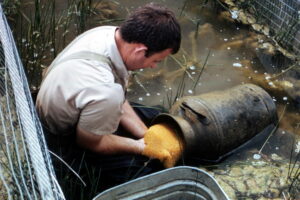The swollen head on this big channel cat indicates it is male ready to guard a nest full of eggs.
When the fish is guarding its eggs, it may not feed for days, making it tough to catch.
Understanding Catfish Spawning Behaviors
By Keith “Catfish” Sutton
Catfish involved with summer egg laying and protection can be difficult to find and hook, but veteran anglers learn a few tricks that can tip the odds in their favor.
“The bluegills are bedding!”
“The white bass are running!”
“Crappie are spawning!”
“Largemouths are moving up shallow!”

Spawning season is peak time to catch many gamefish, and when the rally cry is heard, folks flock to the water to enjoy some of the year’s best action. The spawning habits of catfish, however, differ greatly from the spawning habits of other gamefish. Catfishing success may take a nosedive when blues, flatheads and channel cats are on their nests, and unless you understand why this occurs, you’re likely to return from a fishing trip frustrated and perplexed.
Our major catfish species spawn during spring or summer when the water warms to an optimal temperature. Channel cats and blues spawn at 70-84 degrees F, but 80-81 degrees is considered best. Flatheads spawn at 66-75 degrees.
Spawning begins at different times in different latitudes, progressing from south to north. With channel cats, for instance, spawning may begin in March or April in South Carolina or Texas, May in Kansas or Iowa, and mid-June to July in South Dakota or Wyoming. Blue catfish spawn April through June in Louisiana, and early July in Iowa. Flatheads spawn in late June in Arkansas but not until weeks later in northern parts of their range.
Nesting Sites
All our cats are cavity nesters. Blue catfish deposit their eggs between rocks, in root wads, depressions, undercut banks or other areas protected from current.
Flatheads select sites such as hollow logs, excavated caves in clay banks, root masses from downed trees or manmade structures such as old tires, car bodies and metal drums.
Channel catfish have been observed to spawn directly on the bottom at sites with no nearby cover, but they usually select dark, secluded spots such as crevices in piles of woody debris, burrows in banks, and spaces between and under rocks.
If suitable spawning habitat is unavailable, catfish may migrate (from a lake into a tributary stream, for example) to find it.
Males Stand Guard
A sexually mature male selects and cleans a nest site and spawns with a female he lures there. After the female lays her mound of sticky yellow eggs, the male fertilizes the mass, drives the female from the nest and begins guard duty. He protects the nest from predators and fans the eggs with his fins to keep them aerated and free from sediments. The eggs hatch in 6-10 days (depending on water temperature), and the compact school of fry remains near the nest a few days before dispersing. The male guards the fry until they leave.
Fishing Gets Tough
Cat fans fishing during the spawn may notice a sharp drop in catch rates because male catfish take little or no food while protecting the nest. Fortunately, the spawn is over in a few days. And because fish in a system don’t all spawn at the same time, a section of river or lake may contain prespawn, spawn and postspawn catfish.

If water conditions are favorable, some active feeders will always be available to catch, so there may be no noticeable decline in fishing success. If poor fishing is noticed and can’t be attributed to other causes, the angler can wait a few days until the spawning peak passes and male cats are feeding once again. (See Brad Durick’s article in this issue.)
Two rather unusual forms of catfishing were derived to take advantage of the catfish’s cavity-nesting habits.
Noodling—also called hogging and grabbling—is the practice of catching catfish with one’s hands or a customized grappling hook when they are in nest cavities (natural and manmade) and easily cornered.
In a modification of this technique called bucket fishing, participants submerse weighted buckets or drums with a semicircular hole cut in the lid. Cats enter the containers to spawn and are captured by lifting the containers from the water using an attached line. This technique is highly effective. A 10- bucket line I helped run in a Louisiana lake produced 10 channel catfish daily on three days in late May.
In waters where catfish are abundant, removing a few ready-to-spawn fish from the population is no more detrimental than removing a few egg-filled bluegills. However, we should all temper our catch-and-eat desires with some common-sense catch-and-release. Keep a few smaller cats to eat, and release larger fish.
Conclusion
Fishing for catfish during their spawning season can be very frustrating. When female cats are laying eggs and males are guarding their nests, they’re often hard to find and difficult to entice. Nevertheless, if you are diligent in your efforts and fish the proper locales, you’re almost certain to discover a pattern that will enable you to catch fish, even during this difficult time.
(In 2022, Keith “Catfish” Sutton was one of the inaugural inductees in the American Catfish Association’s Catfish Hall of Fame)



